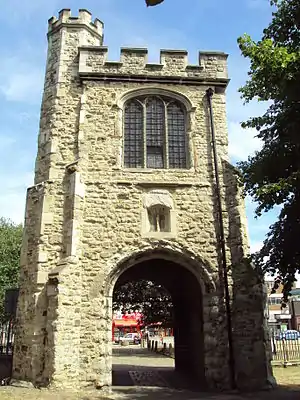Hildelith
Hildelith of Barking, also known as Hildilid or Hildelitha, was an 8th-century Christian saint,[2] from Anglo-Saxon England but of foreign origin.[1]
Saint Hildelith | |
|---|---|
| Abbess | |
| Feast | 22 December (Martyrologium Anglicanum),[1] 24 March.[1] |

Very little is known of her life; however, she is known to history mainly through the hagiography of the Secgan Manuscript,[3] and the Life of St Hildelith written in 1087 by the Medieval Benedictine hagiographical writer Goscelin.[4] She was abbess of the nunnery at Barking in England.[5] She was also the superior to Cwenburh of Wimborne prior to that saint's founding of Wimborne Abbey.
Abbess of Barking
Earconwald is said to have engaged Hildelith to instruct his sister Æthelburh, abbess of the monastery which he had founded at Barking.[1] Hildilid succeeded her pupil as abbess at some date later than 692, if we accept the charter of Æthelred to Æthelburga given under that date (Kemble, Codex Dipl. i. 39).[1] According to another account it must have been after the death of Earconwald (693), who died on a visit to his sister. Florence of Worcester, however, gives her accession under 664, but again mentions it under 675 (i. 27, 33).[1]
Bede speaks of Hildilid's long rule, of her translation of the bones of saints into the church of St. Mary and of a miraculous cure of a blind man which took place in her time.[1][6]
It is not known who replaced her as the next known abbess is Wulfhild of Norway, three centuries later and just prior to the Norman Invasion. She was unique in that under her control the abbey acted as a double monastery.[7]
Death and burial
The date of Hildilid's death is uncertain, but Bede speaks of her long rule and says she lived to a great age.[1] A letter dated to 716 from Saint Boniface to Eadburga, Abbess of Minster mentions Hildilid[1] as the original souce for his Vision of the Monk of Wenlock, but he does not indicate whether she was at the time still living or dead.[8] She was abbess until about 700 AD and she may have died about 725 AD, being buried in Barking. On the other hand, an excavation of Hartlepool Abbey in 1833 found human burials and Anglo-Saxon artefacts, several of which, in consultation with the British Archaeological Association, were identified, including Hildelith, along with two other nuns of Barking Abbey, Eadgyd and Torchtgyd.[9]
References
- Charles Lethbridge Kingsford, Hildilid (DNB00), Dictionary of National Biography, 1885-1900, Volume 26
- The Oxford Dictionary of Saints
- Stowe MS 944, British Library
- M.L. Colker, Lives of the female saints of Barking Abbey, "Texts of Jocelyn of Canterbury which relate to the history of Barking Abbey." Studia Monastica 7.2 (1965). 383-460.
- William Page & J. Horace Round, ed. (1907). 'Houses of Benedictine nuns: Abbey of Barking', A History of the County of Essex: Volume 2. pp. 115–122.
- Hist. Eccl. iv. 10 Bædæ Hist. Eccl. and Florence of Worcester in Engl. Hist. Soc
- Hollis, Stephanie. Anglo-Saxon Women and the Church: Sharing A Common Fate. Rochester: Boydell, 1992. p259.
- Emerton, Ephraim. The Letters of St. Boniface. Records of Civilization: Sources & Studies 31. New York: Columbia University Press, 1940, 25.
- 1873. A Handbook for Travellers in Durham and Northumberland. J. Murray, page 116
